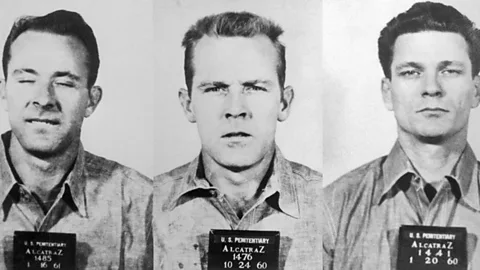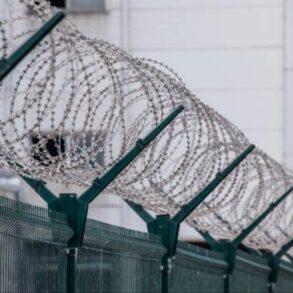By Myles Burke,
 Getty Images
Getty ImagesOn 12 June 1962, three men escaped from Alcatraz, never to be seen again. The ultimate fate of Frank Morris and the Anglin brothers remains a mystery but the ingenuity and determination of their daring escape – from what was the US’s most secure prison – continues to captivate. Two years later, the BBC returned to the scene of the crime.
In May 1964, BBC Panorama’s Michael Charlton made “the most feared journey in the criminal world” across the churning waters of San Francisco Bay to see the infamous prison island of Alcatraz. Nicknamed “the Rock”, the federal penitentiary had held some of the most dangerous criminals in the US. It was regarded as an impregnable fortress. But in the early hours of 12 June 1962, three men achieved what was thought impossible: they escaped.
Alcatraz had originally been a naval defence fort to protect the entrance to the bay. During the US Civil War, because of the island’s isolation, steep cliffs and the swift, cold currents that surrounded it, captured Confederate prisoners were held there. Early in the 20th Century it was rebuilt as a military prison. In the 1930s, as the US tried to deal with rampant organised crime that flourished during Prohibition, the Department of Justice took it over. Soon the most fearsome convicts from the federal prison system began arriving. Among its more famous inmates were the notorious gangsters Al Capone, Mickey Cohen and George “Machine Gun” Kelly, as well as convicted murderer Robert Stroud, who would later become better known as the “Birdman of Alcatraz”. “Men too vicious and troublesome to be held in an ordinary jail,” was the way the BBC’s Charlton put it.
Four years before Panorama travelled there, Frank Lee Morris had arrived on the island. Orphaned at the age of 11, and convicted of his first crime by the age of 13, Morris had spent most of his life in and out of various correctional facilities. Considered highly intelligent, he was a seasoned criminal, with a charge sheet ranging from drug possession to armed robbery and, perhaps most notably, prison breaks. He had been sent to the Rock in January 1960 following his escape from Louisiana State Penitentiary. As soon as he arrived on Alcatraz, he began to think about how he would leave. He was joined in his cell block by convicted bank-robbing brothers John and Clarence Anglin and Allen West, who had been an inmate on Alcatraz since 1957. All the men knew each other from previous stints in prisons together, and since they had adjoining jail cells, they were able to speak to each other at night.
When the BBC’s Charlton visited the site, a year after its closure, he was well aware of the prison’s formidable reputation for unrelenting guards, harsh conditions and the punishing sea winds that the convicts had to endure. “A relentless wind which never seems to stop, howls and echoes through the bars,” he said. “Built over the rambling passages of an old fort… the foundations today of Alcatraz are rotting and breaking up.”
An elaborate plan
With Morris taking the lead, the four prisoners began to concoct an elaborate and audacious plan to escape. Over a period of several months, the men chiselled away at the salt-damaged concrete around the air vent under their sinks. Using metal spoons purloined from the dining hall, a drill made from a vacuum-cleaner motor and discarded saw blades, they dug through to an unguarded utility corridor. To mask the noise of the drill, Morris would play his accordion during the daily hour set aside when music was played to the prisoners. Once they had created a hole large enough to crawl through to the corridor, they climbed up to the empty top level of the cellblock and set up a secret workshop. To hide the cell-wall holes, they fashioned fake papier-mâché grills from prison library magazines. Once they were in their workshop, they set about constructing a 6x14ft makeshift rubber raft and life-vests made from more than 50 stolen raincoats. To seal the rubber, they melted it using the prison’s hot steam pipes. They then converted a concertina into a tool to inflate the raft and fashioned paddles out of bits of plywood.
But while they worked, they needed to conceal their absence from the guards who periodically made night-time checks. So, they sculpted papier-mâché versions of their heads from soap, toothpaste and toilet paper. To make them look more realistic, they used real hair from the prison barbershop floor and painted them in flesh tones using stolen art supplies. These they would then place in their beds, with bundles of clothes and towels under their blankets in the shape of their bodies to make it look like they were asleep. As they worked on their makeshift escape gear, they were also looking for a way out. Using plumbing piping as steps, they climbed 30 feet (9.1m) and prised open the ventilator at the top of a shaft. They crafted a fake bolt out of soap to keep it in place.
Finally, on the night of 11 June 1962, they were ready to put their ingenious plan into motion. Leaving the dummy heads in their beds to fool the guards, Morris and the two Anglin brothers crawled out through the holes on the cell walls. West’s escape was scuppered when he was unable to get out of his cell in time, so the others left without him. They climbed up to the cellhouse roof, ran across it – carrying their makeshift boat, in sight of the guard tower – shimmied down an outside drainpipe, crossed the prison yard, scaled two successive 12-ft (3.7m) barbed wire fences and scrambled down a steep embankment to the north-eastern shore of the island. At the water’s edge, they inflated their boat and disappeared into the night. The alarm wasn’t raised until the following morning, when the decoy heads were discovered.
The island was also home to the families of guards who worked at the prison. Jolene Babyak’s father, who was acting warden at Alcatraz at the time, triggered the alarm. “When I woke up, the siren was still going. It was very piercing, extremely loud, it was horrible, it was pretty scary,” she told BBC Witness History in 2013. “I was shocked you know, and my first thought was that can’t be an escape attempt, and, of course, it was.”
The prison went into immediate lockdown with an intensive search of all the buildings, including the prison officers’ accommodation. Meanwhile Jolene’s father launched a massive manhunt with hundreds of law enforcement personnel extensively searching the surrounding area for days. On 14 June, the Coast Guard found one of the prisoners’ paddles. The same day, workers found a packet of the Anglins’ personal effects, sealed in rubber. Seven days later some remnants of the raft were washed up near the Golden Gate Bridge and the following day one of the homemade life-vests was discovered. But the three fugitives were never seen again.
An open case
Although the prisoners escaped the prison, the authorities concluded they must have perished in treacherous waters attempting to leave the island. That was certainly the view of prison warden Richard Willard when the BBC interviewed him in 1964.” Yes, we are short a few, but they are not bragging about it. In other words, that assumedly all those that we are short, drowned in the procedure. There is, to our knowledge, nobody walking the streets today bragging about having escaped from Alcatraz,” he said. “Why am I so sure? You hear the wind, don’t you? And you see the water? Do you think you could make it?”
Alcatraz prison shut down in 1963, a year after the men’s escape. Partly this was due to its deteriorating structure and the expense of running it but the prison’s severe regime had also long been subject of controversy. As early as 1939, US Attorney General Frank Murphy had tried to close it down, saying: “the whole institution is conducive to psychology that builds up a sinister and vicious attitude among the prisoners”.
In History
Over the years, prisoners had killed or maimed themselves – unable to face the unrelenting conditions – and as the 1960s progressed, the US looked towards rehabilitation of inmates rather than just their punishment.
As for the three escapees, despite no bodies ever being found in the bay, in 1979 they were declared legally dead. The FBI closed its case and turned over responsibility to the US Marshals Service.
But speculation about their fate has never waned. The same year they were declared dead, the film Escape from Alcatraz was released with Clint Eastwood portraying Frank Morris. And from the moment of their escape in 1962, there were reports of alleged sightings of the men, and of messages from them.
In 2018, San Francisco police revealed they had been sent a mysterious letter five years earlier, from someone claiming to be John Anglin. The letter read “I escape from Alcatraz in June 1962. Yes we all made it that night, but barely!” The letter maintained that the men had lived on in secret, with Frank Morris dying in October 2005, and Clarence Anglin in 2008. The letter’s author said he now wanted to negotiate his surrender in exchange for cancer treatment. The FBI assessed the letter but were unable to verify if it was authentic or not.
The case is still open for the US Marshals Service. As recently as 2022, it released updated pictures of what the three missing Alcatraz prisoners might look like now, while appealing for any information about them, in the hope that finally it could put the mystery to bed.
For more stories and never-before-published radio scripts to your inbox, sign up to the In History newsletter, while The Essential List delivers a handpicked selection of features and insights twice a week.
This post was originally published on this site be sure to check out more of their content.









